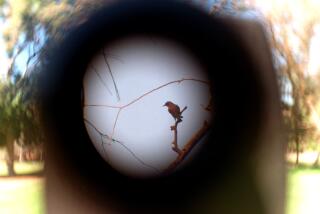Caught on tape! Wild crows use tiny cameras to film themselves using tools
- Share via
Two species on Earth are known to use hook-shaped tools: humans and New Caledonian crows. And now, for the first time, the people have caught the birds using them on camera.
There are crows all over the world, but the species on New Caledonia, a forested island in the South Pacific, are renowned for their ability to make and use tools. Among other things, they fashion sticks into sharp poking instruments and use them to “fish” for wood-boring larvae hiding in dead wood or tree trunks.
In a new study, scientists describe how they captured some of the crows’ most complex handiwork on video, thanks to specialized miniature cameras and 19 avian auteurs.
“We’d seen it before and other researchers had seen it, but nobody had managed to shoot any videos,” said Christian Rutz, a behavioral ecologist at the University of St. Andrews in Scotland and coauthor of the study, published this week in Biology Letters.

Ecologists Jolyon Troscianko and Christian Rutz attached specialized cameras to capture video footage of New Caledonian crows making and using stick tools, foraging for insects and feeding a frog to juvenile birds. The New Caledonian species is reno
Rutz, then at Oxford, and Jolyon Troscianko, then a graduate student at the University of Birmingham, created “mini spy cams” specially fitted for birds. In late 2009, the researchers deployed them on 19 wild New Caledonian crows in hopes of documenting the birds’ unusual behavior with hooked stick tools.
“Some people think you need a large brain to use tools. These crows disprove that,” Rutz said. “They show incredibly complex tool behavior. The big question is: Why and how? What is special about the crows on this island?”
Other bird species are known to use tools. For instance, the Galapagos woodpecker finch uses cactus spines and twigs to hunt for insects, and the Egyptian vulture bangs stones against ostrich eggs to crack them open.
But the New Caledonian crow actually fashions its tools into a hook shape, which is unheard of for any non-human species. This gives the crows access to food sources that are hard to reach by using only their beaks.
Join the conversation on Facebook >>
Difficult island terrain makes it hard for researchers to watch the birds directly. Researchers who have tried have run into some problems.
The crows “are so curious as a species that they would start observing us instead of the other way around,” Rutz said. “The bird would approach us and observe our cameras and binoculars.”
Instead, the scientists decided they needed a way to see through the eyes of the crow.
First, they built a camera that could attach to the underside of the birds’ tail feathers. These early crow cams transmitted live video back to a field worker.
But they kept losing reception.
Inevitably, something exciting would happen, “but the next second we lost the radio transmission link,” Rutz said. “We had all these snippets of footage, but very rarely did we have long, uninterrupted sequences of recordings.”
Rutz and Troscianko thought they could get around this by recording onto micro-SD cards inside the cameras. But that meant they’d have to retrieve the cameras after they let wild birds fly away with them.
So they devised a decidedly low-tech solution: They used pieces of cheap birthday party balloons to attach the cameras to the birds’ tail feathers. After about a week, sunlight would degrade the rubber enough for the balloon to break and the camera to fall to earth.
After that, Rutz and Troscianko used embedded radio transmitters to track the cameras and pick them up.
“Once you have a stationary signal for quite a while … chances are you either have a sleeping crow or the [camera] has fallen off,” Rutz said.
Once they retrieved a camera, they’d race back to their base camp to watch the footage right away.
“It’s incredibly exciting,” he said. “You can hitch a ride with a crow as it flies through the forest and it does its thing.”
Altogether, the pair was able to retrieve 10 of the 19 cameras. That yielded more than 10 hours of footage to analyze.
The birds recorded themselves foraging and feeding on various insects and fruits. In one clip, a crow fed portions of a small frog to a juvenile.
See the most-read stories in Science this hour >>
Most important, four of the crows filmed themselves using tools.
Those four birds spent 19% of their foraging time using their tools. (The rest of the time, they were using their beaks.) The researchers hope to eventually learn what makes the crows reach for a tool in a particular situation.
The fact that only four of the 10 crows were seen using tools raises some trickier questions.
Does this mean the cameras didn’t happen to be recording when the other birds were using tools? Or is it a sign that some New Caledonian crows don’t use tools at all?
Either way, Rutz hopes his videos can provide some insight into bigger questions about how tool using evolved and why it’s so rare in nature.
“That seems to be an evolutionary puzzle,” he said. “Why do so few animals use tools, and why are we humans so good at it?”
Follow me on Twitter @seangreene89
MORE FROM SCIENCE
Fireball seen passing over Southern California is identified as Russian space junk
On the moon, China’s Chang’e 3 Yutu rover finds a new type of basaltic rock
Dog domestication saddled man’s best friend with defective genes, study says







